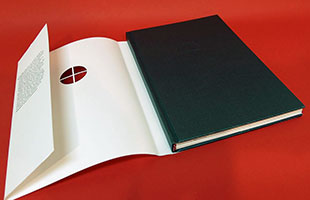
Catholics
By Matt Runkle
Iowa City: Matt Runkle, 2015. Edition of 25.
6 x 9"; 90 pages. Letterpress and laser printed. Non-typographic images drawn and collaged, then reproduced using laser printing or letterpress printing from photopolymer plates. Flat spine binding in full cloth. In white dustjacket with titles and author on spine. Numbered and signed by the artist.
Matt Runkle: "'Catholics' is an artist book, a limited-edition memoir that makes use of illustration, collage, and letterpress-printed typography to explore the psychic cathedral built by my Catholic traditionalist upbringing. Beginning with an anti-clerical quip by Tallulah Bankhead, the book takes on a range of subjects including Catholic-Masonic tensions, the fervency of converts, the legacy of the Legion of Decency, and the spiritual significance of revelatory shrouds. In 'Catholics', the sacred and profane, the humorous and tragic, the zine and literary fine-press all end up as strange bedfellows in desperate need of confession.
"The book's eight prose sections are both anecdotal and informational. Their design is a nod to twentieth-century trade publications — books, but also periodicals. In these sections, magazines and newspapers recur as central objects, and the tell-all nature of the book’s subject matter often feels worthy of the scandal sheets. Because of this, I’ve drawn inspiration from the designers, compositors, and printers who once worked to produce mass-market ephemera. … "
Also included at intervals, always on the recto, is a series of seven communion wafers/solar crosses. Printed with heavy impression from photopolymer plates, these images are surrounded by Bruce Rogers–inspired frames printed from metal typographic ornaments that alchemically shift throughout the course of the book. The wafers/solar crosses animate their own narrative, a transmuting framework that comments on the book’s other threads. …
"The book’s three illustrated saints—portrayed by Joan Crawford and Tallulah Bankhead—are directly referenced in the prose sections, as are the objects surrounding them. Their layout is inspired by the quincunx, a sacred formation where one central image is surrounded by four smaller objects at each corner. In Renaissance art, these four objects often represent aspects of the fourfold world: humors, elements, seasons, gospels, or some other system of correspondences. …
"Three eulogiae — portfolios in the spirit of acheiropoieta (icons generated miraculously rather than by human hand) — rely heavily on collage. Sixth-century pilgrims to sacred sites in Europe carried away tiny clay or glass ampullae that contained traces of dirt, oil, or water found at the visited shrine. Diagrammatic images of the location were also rendered on the exteriors of these souvenirs, called eulogiae. Each eulogia in 'Catholics' attempts to conjure remembered space in a similar way: handwritten text and collaged images function as both architecture and performance."
$950